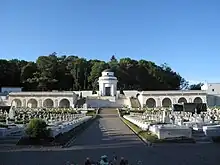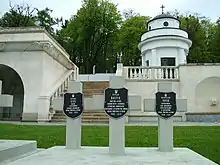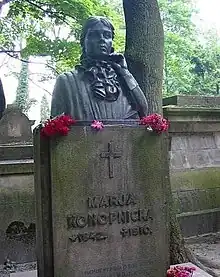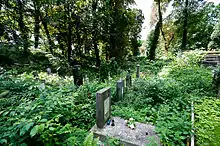| Lychakiv Cemetery Ukrainian: Личаківський цвинтар Polish: Cmentarz Łyczakowski | |
|---|---|
 One of the cemetery alleys, 2007. | |
| Details | |
| Established | 1787 |
| Location | |
| Country | Ukraine |
| Coordinates | 49°49′59″N 24°03′22″E / 49.833°N 24.056°E |
| Type | Public (restricted) |
| Size | 40 ha |
| No. of graves | more than 300,000 |
Lychakiv Cemetery (Ukrainian: Личаківський цвинтар, romanized: Lychakivs’kyi tsvyntar; Polish: Cmentarz Łyczakowski we Lwowie), officially State History and Culture Museum-Preserve "Lychakiv Cemetery" (Ukrainian: Державний історико-культурний музей-заповідник «Лича́ківський цви́нтар»), is a historic cemetery in Lviv, Ukraine.
History
.JPG.webp)
Since its creation in 1787 as Łyczakowski Cemetery, it has been the main necropolis of the city's (at the time named Lemberg[1]) intelligentsia, middle and upper classes. Initially the cemetery was located on several hills in the borough of Lychakiv, following the imperial Austro-Hungarian (the city was located in Austria-Hungary at the time[1]) edict ordering that all cemeteries be moved outside of the city limits. The original project was prepared by Karol Bauer, the head of the Lviv University botanical garden.
In mid-1850s the cemetery was expanded significantly by Tytus Tchórzewski, who created the present network of alleys and round-abouts. It then became the main city cemetery, and soon most other cemeteries were closed. The two largest that remained were the Yanivskiy Cemetery (Polish: cmentarz Janowski), with many working class graves and the adjacent New Jewish Cemetery. Lychakivskiy Cemetery was used by all Christian sects in the city: in addition to Roman Catholics, it also included Eastern Rite Catholics, Protestants and Orthodox.
After World War II the city (at the time named Lwów[1]) was annexed (from the Second Polish Republic[1]) by the Soviet Union to the Ukrainian Soviet Socialist Republic. The majority of the surviving pre-war inhabitants of the city were expelled to the former German areas awarded to Poland after the Yalta Conference. This started a period of devastation of historical monuments located at the cemetery. Up to 1971 many of the sculptures were destroyed. However, in 1975 the cemetery was declared a historical monument and the degradation ended. Since the late 1980s, the cemetery has seen constant rebuilding and refurbishment and continues to be one of the principal tourist attractions of Lviv.
In late 2006 the city administration announced plans to transfer the tombs of Stepan Bandera, Yevhen Konovalets, Andriy Melnyk and other key leaders of Organization of Ukrainian Nationalists (OUN) / Ukrainian Insurgent Army (UPA) to a new area of the cemetery dedicated to the Ukrainian national liberation struggle.[2]
Cemetery sections

1
2
3
4
5
6
7
8
9
|
Lychakiv Cemetery plan
|

Ukrainian National Army Memorial
The Ukrainian National Army Memorial (Number 8 on the plan) is devoted to the Ukrainian National Army soldiers buried in the cemetery, including soldiers of the SS Division "Galicia". It was established due to the efforts of Ukrainian national-patriotic organizations and the Ukrainian emigrant veterans' movement. It was established with the special effort of Ferentsevich Yuri, a division veteran, Ukrainian emigrant veterans' movement social activist and Plast (National Scout Organization of Ukraine) veteran who took an active part in the creation of memorials to the SS Division Galicia on the mountain Zhbyr and near the village of Chervone.[3]
Field of Mars
On the north side of the Cemetery is situated Field of Mars (No. 1 on the plan), a war memorial built in 1974. This war memorial contains the graves of 3,800 Soviet soldiers who died in the battles against the Nazi occupiers during World War II) (named Great Patriotic War in Soviet ideology[4]) and against units of Ukrainian Insurgent Army (UPA) (acting up to the mid-1950s). On the wall of the memorial was written a verse:
At the middle of the planet
in the storm clouds thunder
deads are watching the sky
believing in the wisdom of livings
Poetic writing in honor of the Soviet soldiers was eliminated at the direction of urban authorities in 1990s.[5]


Lwów Defenders' Cemetery
The Cemetery of the Defenders of Lwów (Cemetery of Eaglets, Polish: Cmentarz Orląt Lwowskich) is a memorial and a burial place for the Poles and their allies who died in Lviv during the hostilities of the Polish-Ukrainian War (1918−1919) and Polish-Soviet War (1919−1921).
The complex is a part of the city's historic Lychakiv Cemetery. There are about 3000 graves in that part of the cemetery; some from the Lwów Eaglets young militia volunteers, after whom that part of the cemetery is named. It was one of the most famous necropolises of the interwar Poland. Lviv was a city in interwar Poland and at the time named Lwów.[1]
In 1925, the ashes of one of the unknown defenders of Lwów were transferred to the Tomb of the Unknown Soldier in Warsaw. After that was built the «Polish mausoleum» (Lwów Eaglets Memorial).
After World War II the cemetery of Lwów Eaglets was completely destroyed and turned into a truck depot and at one time Eaglets Cemetery was damaged with a bulldozer.[6]
Due to the history of complex Polish-Ukrainian relations, the Polish Eaglets Cemetery was neglected because the Ukrainian authorities did not want to rebuild this monument of young Polish soldiers defending the city in 1920s. Though in the late 1980s, workers of a Polish company which were working in Khmelnytskyi started to redecorate and rebuild the necropolis from its ruins (which was not always legal according to Ukrainian law). Although the Ukrainian authorities tried to stop the works several times, the Poles managed to renovate this important memorial of great Lvovians.
Since 1999 there is also a monument to the Sich Riflemen located just outside the Polish mausoleum.
Since the fall of communism, the cemetery had been rebuilt and refurbished. It was finally reopened on 24 June 2005.
1863 January rebels' hill
In the back part of the cemetery (No. 6 on the plan) on a separate field indicated original steel crosses, located «1863 rebels' hill». Buried here are members Polish January Uprising of 1863, of which a member of the Polish Central National Committee Bronisław Szwarce, the famous zoologist Benedykt Dybowski, cornet Vitebsk land, resting under the central monument rebels Shimon Vizunas Shidlovsky, etc.
Other veterans' sections
There are also numerous parts of the cemetery in which veterans of most wars of 19th and 20th centuries are buried, including the quarters of veterans of:
- November Uprising (1830−1831)
- World War I
- Polish Defensive War (1939)
- Victims of the NKVD (1941)
- World War II
Notable people



Poles
Since the city for centuries used to be a centre of Polish culture, there are numerous famous Poles buried there. Among them are:
- Roman Abraham, general
- Stefan Banach, mathematician
- Wladyslaw Belza, writer
- Piotr Chmielowski, philosopher
- Benedykt Dybowski, soldier, adventurer, ethnologist and biologist
- Mieczysław Garsztka, aviator
- Mieczysław Gębarowicz, historian
- Tadeusz Rozwadowski, Polish military leader and one of the founders of modern Poland
- Franciszek Ksawery Godebski, historian
- Zygmunt Gorgolewski, architect, designer of the Lviv Opera
- Seweryn Goszczyński, poet
- Artur Grottger, artist
- Jan Nepomucen Kamiński, founder of the first theatre in Lwów
- Wojciech Kętrzyński, historian and name-sake of the city of Kętrzyn
- Maria Konopnicka, writer
- Juliusz Konstanty Ordon, officer
- Ludwik Rydygier, surgeon
- Władysław Sadłowski, architect
- Kazimierz Sichulski, painter
- Karol Szajnocha, historian
- Julian Zachariewicz, architect
- Gabriela Zapolska, novelist and playwright
Ukrainians
Among the notable Ukrainians buried there are:
- Oleksander Barvinsky, academician, politician.
- Vasyl Barvinsky, impressionist composer
- Yevheniya Barvinska, pianist, choral conductor, singer
- Roman Bezpalkiv, Ukrainian painter
- Ivan Franko, poet and reformer of the Ukrainian language
- Yaroslav Halan, playwright and publicist
- Jacques Hnizdovsky, painter, printmaker, sculptor, bookplate designer and illustrator of numerous books, both in Ukrainian and English
- Volodymyr Ivasyuk, composer
- Mykhaylo Kobryn, theologian
- Solomiya Krushelnytska, soprano opera star
- Lesya Kryvytska, actress
- Stanyslav Lyudkevych, composer
- Oleksander Ohonovsky, lawyer, civic leader
- Anthony Petrushevych, historian and philologist.
- Markiyan Shashkevych, poet
- Yurii Shukhevych, political prisoner and politician
- Oleksandr Tysowskyj (alternately Alexander Tysovsky), founder of Ukrainian Scouting
- Anatole Vakhnianyn, composer and leading cultural figure
- Iryna Vilde (Polotniuk), Ukrainian writer
- Borys Voznytsky, hero of Ukraine, academician, director of the Lviv National Gallery
- Yuriy Starosol'skyi, Chief Scout of Plast from 1972 to 1991
Others
- Edmund Pike Graves, pilot and member of the Kościuszko Squadron
Gallery
 Lychakiv Cemetery – main gate (c.a. 1900)
Lychakiv Cemetery – main gate (c.a. 1900)![Mausoleum of Kiselka family by Filip Pokutyński [pl]](../I/Lw%C3%B3w_-_Cmentarz_%C5%81yczakowski_02.JPG.webp) Mausoleum of Kiselka family by Filip Pokutyński
Mausoleum of Kiselka family by Filip Pokutyński.jpg.webp) Lychakiv Cemetery (2018)
Lychakiv Cemetery (2018)
References
- 1 2 3 4 5 Tong King Lee (2021), The Routledge Handbook of Translation and the City, New York City, New York and London, England: Routledge, ISBN 9781138348875
- ↑ NKVD victims to be buried in Lviv on November 7 // «ForUm» (www.for-ua.com) 25 October 2006. Archived 1 November 2006 at the Wayback Machine
- ↑ Дяків М. Відійшов на Вічну Ватру пластун сеньйор керівництва Юрій Ференцевич з куреня «Ватага Бурлаків» // «Пластовий портал» (www.plast.org.ua) 15.02.2011.(in Ukrainian) Archived 2014-10-06 at the Wayback Machine
- ↑ Friedrich Gorenstein (2019). Redemption. The Russian Library. Translated by Andrew Bromfield. Columbia University Press. ISBN 978-023118515-8.
- ↑ Lemko I.. Pogulyanka with Outskirts // «Lviv newspaper» – 13 Lipnya 2007.(in Ukrainian)
- ↑ Symbolic Reconciliation, 20 July 2005, Warsaw Voice. Last accessed on 22 March 2006.
External links
- Detailed history of the Cemetery (in Polish)
- Pictures of the Cemetery. 288 photo. V.Yashchuk
- Pictures of the Cemetery (in Polish)
- More pictures of the Cemetery (captions in Polish)
- Pictures of Defenders of Lwów Cemetery (in Polish)
- Lychakivskiy Cemetery on city plan: F-9; Inter-war cemetery list, p. 23, Plan Lwowa, W. Horbay, 1938 (in Polish; reprinted Wrocław, 1986).
- Review of Cemetery as tourist attraction
- Article about Cemeteries Tourist
- Lychakivskiy Cemetery at Find a Grave
